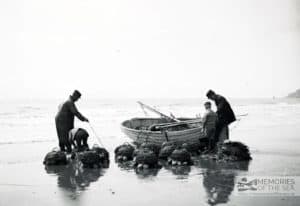John Luff and John Woodford on Fishing
John L: That Widness chap told me, this is Ashford Caws, he taught me these pots one winter and I was as proud as Punch, you know. He said, “Now I’ve shown you how to make ‘em, I suppose you want me to show you where to put them. So, I said to him, “You can come out in the boat with me.” He was 90 and he come out in the boat with me and he used to row, thoroughly enjoyed himself.
Lisa: So, is there quite an art to making the pots then?
John L: Yeah, I think I’m the only one on the Island that can do it. I’ve seen them on the television making lobster pots down the West Country similar to what we used to make but the trouble is you couldn’t do one indoors. I make these indoors in here in the winter, but a lobster pot is so big and where they are six feet long, you couldn’t do anything in here, so you got to do it outside. And the only difference is I buy those in because where we had withy beds, they’ve been built on, been sold and built on, so I buy those. They’re basket making willows from Somerset and the only problem is, you have to soak them to make them pliable and if you’re doing it in the summer, they dry out quick and you’ve got to keep on soaking and soaking but they make a decent pot.
Lisa: How long does a pot last?
John L: It all depends on the weather and all sorts of things, but lobster pots weren’t dipped in tar, they were just bare so they possibly … it all depends if you had a blow or you got a big crab in there and he decided he wanted to bite his way out. Lobster pots wouldn’t last as long as shrimp pots.
A shrimp pot, you might be lucky and get three years out of it with repair, so you always had to make new ones in the winter to just keep the numbers up.
And then you had to wait for a hot day in August to tar them because otherwise it would clog, so you wanted a hot day and hot tar and used to have, you know the old water tanks you used to have in your roof, put the tar in, fire underneath and then you had a corrugated sheet running down and it had to be a hot day and then you dipped them and then you put them on the corrugated sheet and the surplus tar would run back into the thing. It was a horrible time.







